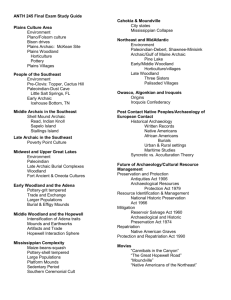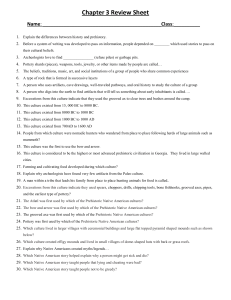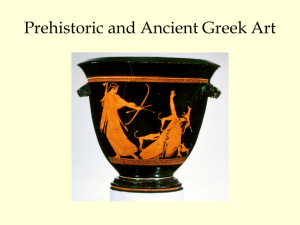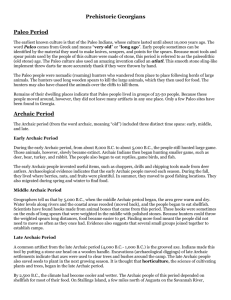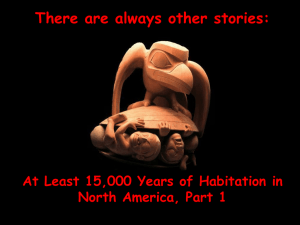Prehistoric Cultures: 9500 B
advertisement
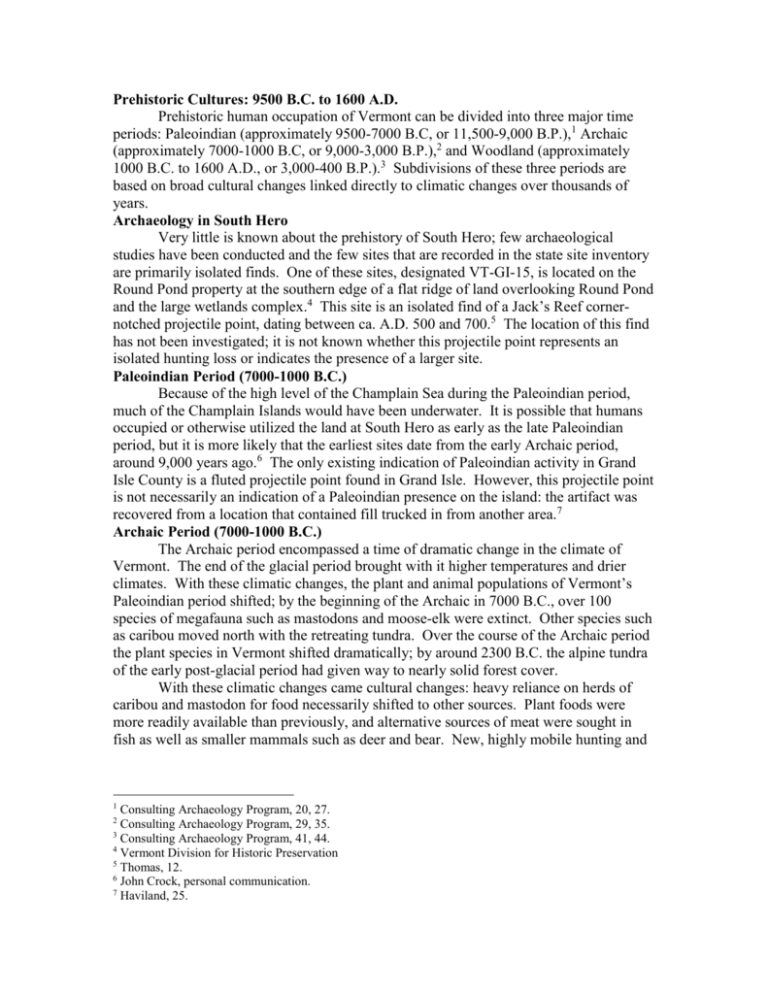
Prehistoric Cultures: 9500 B.C. to 1600 A.D. Prehistoric human occupation of Vermont can be divided into three major time periods: Paleoindian (approximately 9500-7000 B.C, or 11,500-9,000 B.P.),1 Archaic (approximately 7000-1000 B.C, or 9,000-3,000 B.P.),2 and Woodland (approximately 1000 B.C. to 1600 A.D., or 3,000-400 B.P.).3 Subdivisions of these three periods are based on broad cultural changes linked directly to climatic changes over thousands of years. Archaeology in South Hero Very little is known about the prehistory of South Hero; few archaeological studies have been conducted and the few sites that are recorded in the state site inventory are primarily isolated finds. One of these sites, designated VT-GI-15, is located on the Round Pond property at the southern edge of a flat ridge of land overlooking Round Pond and the large wetlands complex.4 This site is an isolated find of a Jack’s Reef cornernotched projectile point, dating between ca. A.D. 500 and 700.5 The location of this find has not been investigated; it is not known whether this projectile point represents an isolated hunting loss or indicates the presence of a larger site. Paleoindian Period (7000-1000 B.C.) Because of the high level of the Champlain Sea during the Paleoindian period, much of the Champlain Islands would have been underwater. It is possible that humans occupied or otherwise utilized the land at South Hero as early as the late Paleoindian period, but it is more likely that the earliest sites date from the early Archaic period, around 9,000 years ago.6 The only existing indication of Paleoindian activity in Grand Isle County is a fluted projectile point found in Grand Isle. However, this projectile point is not necessarily an indication of a Paleoindian presence on the island: the artifact was recovered from a location that contained fill trucked in from another area.7 Archaic Period (7000-1000 B.C.) The Archaic period encompassed a time of dramatic change in the climate of Vermont. The end of the glacial period brought with it higher temperatures and drier climates. With these climatic changes, the plant and animal populations of Vermont’s Paleoindian period shifted; by the beginning of the Archaic in 7000 B.C., over 100 species of megafauna such as mastodons and moose-elk were extinct. Other species such as caribou moved north with the retreating tundra. Over the course of the Archaic period the plant species in Vermont shifted dramatically; by around 2300 B.C. the alpine tundra of the early post-glacial period had given way to nearly solid forest cover. With these climatic changes came cultural changes: heavy reliance on herds of caribou and mastodon for food necessarily shifted to other sources. Plant foods were more readily available than previously, and alternative sources of meat were sought in fish as well as smaller mammals such as deer and bear. New, highly mobile hunting and 1 Consulting Archaeology Program, 20, 27. Consulting Archaeology Program, 29, 35. 3 Consulting Archaeology Program, 41, 44. 4 Vermont Division for Historic Preservation 5 Thomas, 12. 6 John Crock, personal communication. 7 Haviland, 25. 2 gathering cultures now known as the Archaic tradition developed with these shifts in the ecology of Vermont.8 At this time there is no known direct evidence of Archaic period activity at the Round Pond site. However, excavations at the Grand Isle Fish Hatchery revealed a late Archaic hunting camp (VT-GI-18). This provides direct evidence of human activity on the island at least as early as 2800 to 2400 B.C. 9 Woodland Period (1000 B.C.-1600 A.D.) This period of time covers the shift from the hunting and gathering cultures of the Archaic period to the more sedentary horticulture-based Abenakis that lived what is now the Champlain Valley at the time of the first European contact in the 17th century. This period is characterized by increasing cultivation of native plants and increasing trade that brought in exotic materials such as copper or different varieties of chert from hundreds of miles away.10 The Jack’s Reef corner-notched projectile point found at site VT-GI-15 on the Round Pond property dates between approximately 500 and 700 A.D., putting it squarely in the Middle Woodland period. No other direct evidence for Woodland period activity at this site is known to exist. Early Contact (1600-1779 A.D.) Prior to any extensive contact with European traders or settlers, the Abenaki societies in Vermont already felt their presence through wave after wave of plague that decimated populations throughout the sixteenth, seventeenth, and eighteenth centuries. Increasing trade with Europeans introduced and iron products and cloth, inciting further broad cultural change, as did opportunities with the newly developing fur industry.11 These changes led to increasing shifts in settlement patterns. While the Abenaki people lived in other areas surrounding Lake Champlain, South Hero was apparently sparsely inhabited or even uninhabited by non-Europeans by 1779. Recommendations The property at Round Pond State Park should be considered highly sensitive; the wetlands and location on the shore of Lake Champlain provided the same attractions for animals in the past as they do today, thereby making this location an excellent site for human activity. Prior to any ground disturbance, a professional archaeologist should make a site visit to conduct preliminary testing and provide recommendations. 8 Haviland, 38. Sloma, 7. 10 Haviland, 153-4. 11 Haviland, 208-213. 9
